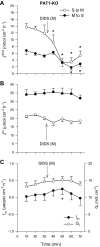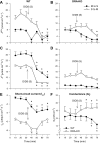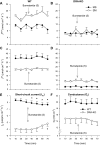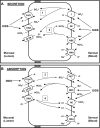Sulfate secretion and chloride absorption are mediated by the anion exchanger DRA (Slc26a3) in the mouse cecum
- PMID: 23660504
- PMCID: PMC3725685
- DOI: 10.1152/ajpgi.00084.2013
Sulfate secretion and chloride absorption are mediated by the anion exchanger DRA (Slc26a3) in the mouse cecum
Abstract
Inorganic sulfate (SO₄²⁻) is essential for a multitude of physiological processes. The specific molecular pathway has been identified for uptake from the small intestine but is virtually unknown for the large bowel, although there is evidence for absorption involving Na⁺-independent anion exchange. A leading candidate is the apical chloride/bicarbonate (Cl⁻/HCO₃⁻) exchanger DRA (down-regulated in adenoma; Slc26a3), primarily linked to the Cl⁻ transporting defect in congenital chloride diarrhea. The present study set out to characterize transepithelial ³⁵SO₄²⁻ and ³⁶Cl⁻ fluxes across the isolated, short-circuited cecum from wild-type (WT) and knockout (KO) mice and subsequently to define the contribution of DRA. The cecum demonstrated simultaneous net SO₄²⁻ secretion (-8.39 ± 0.88 nmol·cm⁻²·h⁻¹) and Cl⁻ absorption (10.85 ± 1.41 μmol·cm⁻²·h⁻¹). In DRA-KO mice, SO₄²⁻ secretion was reversed to net absorption via a 60% reduction in serosal to mucosal SO₄²⁻ flux. Similarly, net Cl⁻ absorption was abolished and replaced by secretion, indicating that DRA represents a major pathway for transcellular SO₄²⁻ secretion and Cl⁻ absorption. Further experiments including the application of DIDS (500 μM), bumetanide (100 μM), and substitutions of extracellular Cl⁻ or HCO₃⁻/CO₂ helped to identify specific ion dependencies and driving forces and suggested that additional anion exchangers were operating at both apical and basolateral membranes supporting SO₄²⁻ transport. In conclusion, DRA contributes to SO₄²⁻ secretion via DIDS-sensitive HCO₃⁻/SO₄²⁻ exchange, in addition to being the principal DIDS-resistant Cl⁻/HCO₃⁻ exchanger. With DRA linked to the pathogenesis of other gastrointestinal diseases extending its functional characterization offers a more complete picture of its role in the intestine.
Keywords: PAT1; Slc26a6; epithelial ion transport; large intestine.
Figures







Similar articles
-
Transcellular oxalate and Cl- absorption in mouse intestine is mediated by the DRA anion exchanger Slc26a3, and DRA deletion decreases urinary oxalate.Am J Physiol Gastrointest Liver Physiol. 2013 Oct 1;305(7):G520-7. doi: 10.1152/ajpgi.00167.2013. Epub 2013 Jul 25. Am J Physiol Gastrointest Liver Physiol. 2013. PMID: 23886857 Free PMC article.
-
Loss of the anion exchanger DRA (Slc26a3), or PAT1 (Slc26a6), alters sulfate transport by the distal ileum and overall sulfate homeostasis.Am J Physiol Gastrointest Liver Physiol. 2017 Sep 1;313(3):G166-G179. doi: 10.1152/ajpgi.00079.2017. Epub 2017 May 19. Am J Physiol Gastrointest Liver Physiol. 2017. PMID: 28526688 Free PMC article.
-
Native and recombinant Slc26a3 (downregulated in adenoma, Dra) do not exhibit properties of 2Cl-/1HCO3- exchange.Am J Physiol Cell Physiol. 2011 Feb;300(2):C276-86. doi: 10.1152/ajpcell.00366.2010. Epub 2010 Nov 10. Am J Physiol Cell Physiol. 2011. PMID: 21068358 Free PMC article.
-
SLC26A3 (DRA, the Congenital Chloride Diarrhea Gene): A Novel Therapeutic Target for Diarrheal Diseases.Cell Mol Gastroenterol Hepatol. 2025;19(6):101452. doi: 10.1016/j.jcmgh.2024.101452. Epub 2024 Dec 28. Cell Mol Gastroenterol Hepatol. 2025. PMID: 39736385 Free PMC article. Review.
-
Dietary fructose, salt absorption and hypertension in metabolic syndrome: towards a new paradigm.Acta Physiol (Oxf). 2011 Jan;201(1):55-62. doi: 10.1111/j.1748-1716.2010.02167.x. Acta Physiol (Oxf). 2011. PMID: 21143427 Free PMC article. Review.
Cited by
-
Segmental differences in Slc26a3-dependent Cl- absorption and HCO3- secretion in the mouse large intestine in vitro in Ussing chambers.J Physiol Sci. 2021 Jan 29;71(1):5. doi: 10.1186/s12576-020-00784-9. J Physiol Sci. 2021. PMID: 33514305 Free PMC article.
-
The anion exchanger PAT-1 (Slc26a6) does not participate in oxalate or chloride transport by mouse large intestine.Pflugers Arch. 2021 Jan;473(1):95-106. doi: 10.1007/s00424-020-02495-x. Epub 2020 Nov 17. Pflugers Arch. 2021. PMID: 33205229 Free PMC article.
-
Absence of the sulfate transporter SAT-1 has no impact on oxalate handling by mouse intestine and does not cause hyperoxaluria or hyperoxalemia.Am J Physiol Gastrointest Liver Physiol. 2019 Jan 1;316(1):G82-G94. doi: 10.1152/ajpgi.00299.2018. Epub 2018 Nov 1. Am J Physiol Gastrointest Liver Physiol. 2019. PMID: 30383413 Free PMC article.
-
Transcellular oxalate and Cl- absorption in mouse intestine is mediated by the DRA anion exchanger Slc26a3, and DRA deletion decreases urinary oxalate.Am J Physiol Gastrointest Liver Physiol. 2013 Oct 1;305(7):G520-7. doi: 10.1152/ajpgi.00167.2013. Epub 2013 Jul 25. Am J Physiol Gastrointest Liver Physiol. 2013. PMID: 23886857 Free PMC article.
-
Effects of acid-base variables and the role of carbonic anhydrase on oxalate secretion by the mouse intestine in vitro.Physiol Rep. 2015 Feb 25;3(2):e12282. doi: 10.14814/phy2.12282. Print 2015 Feb 1. Physiol Rep. 2015. PMID: 25716924 Free PMC article.
References
-
- Alrefai WA, Tyagi S, Mansour F, Saksena S, Syed I, Ramaswamy K, Dudeja PK. Sulfate and chloride transport in Caco-2 cells: differential regulation by thyroxine and the possible role of DRA gene. Am J Physiol Gastrointest Liver Physiol 280: G603–G613, 2001 - PubMed
-
- Alrefai WA, Tyagi S, Nazir TM, Barakat J, Anwar SS, Hadjiagapiou C, Bavishi D, Sahi J, Malik P, Goldstein J, Layden TJ, Ramaswamy K, Dudeja PK. Human intestinal anion exchanger isoforms: expression, distribution, and membrane localization. Biochim Biophys Acta 1511: 17–27, 2001 - PubMed
-
- Alper SL, Rossmann H, Wilhelm S, Stuart-Tilley AK, Shmukler E, Seidler U. Expression of AE2 anion exchanger in mouse intestine. Am J Physiol Gastrointest Liver Physiol 277: G321–G332, 1999 - PubMed
-
- Antalis TM, Reeder JA, Gotley DC, Byeon MK, Walsh MD, Henderson KW, Papas TS, Schweinfest CW. Down-regulation of the down-regulated in adenoma (DRA) gene correlates with colon tumor progression. Clin Cancer Res 4: 1857–1863, 1998 - PubMed
Publication types
MeSH terms
Substances
Grants and funding
LinkOut - more resources
Full Text Sources
Other Literature Sources
Molecular Biology Databases
Research Materials

